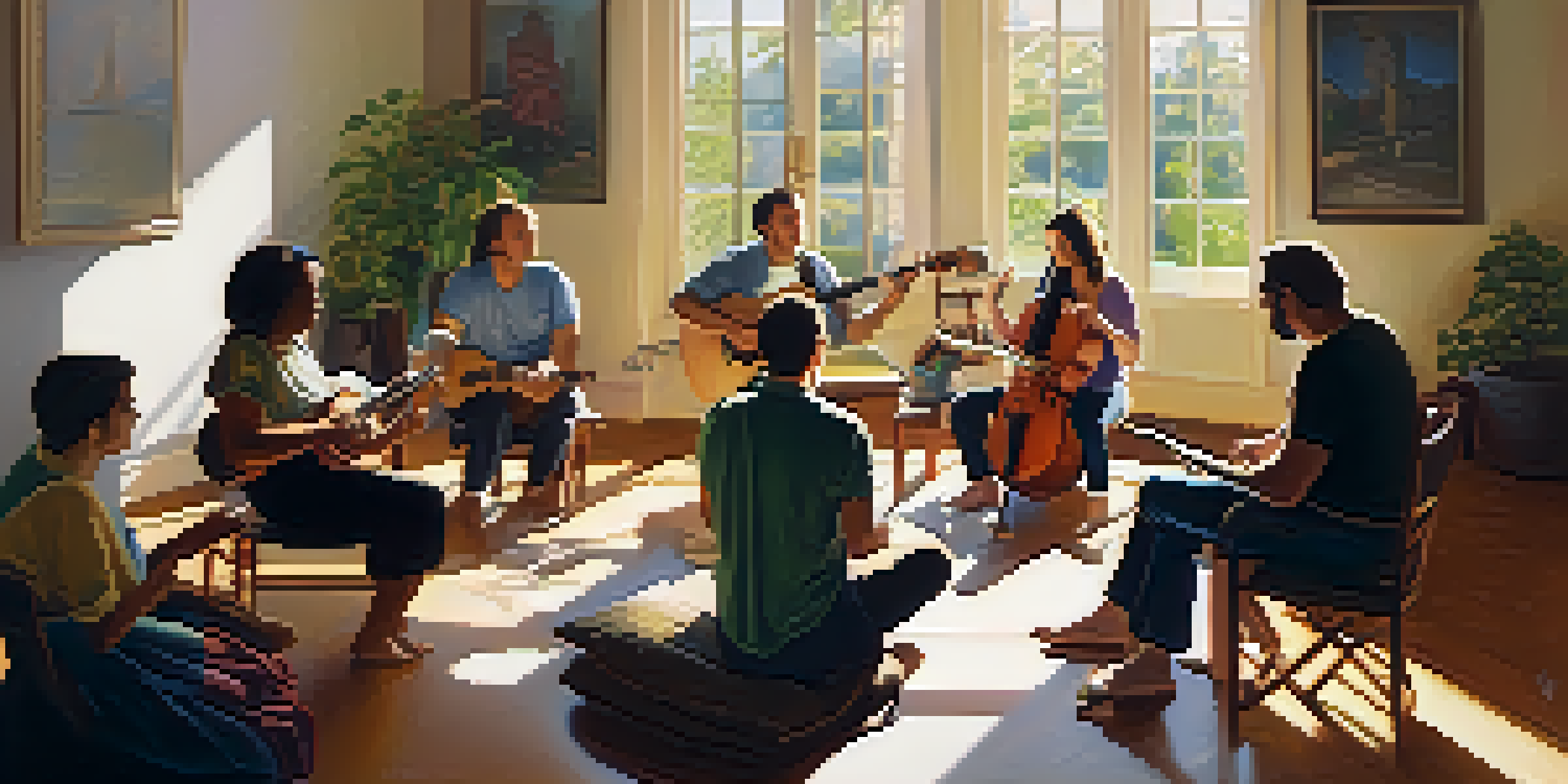The Role of Music in Group Therapy: Building Connections

Understanding Group Therapy and Its Benefits
Group therapy is a powerful tool for healing, allowing individuals to share their experiences in a supportive environment. Participants often find solace in knowing they are not alone, which can reduce feelings of isolation. The collective energy in a group can amplify personal insights, making the therapeutic process more impactful.
Music can change the world because it can change people.
In this setting, music acts as a universal language, breaking down barriers and fostering connections among participants. It can evoke emotions, stimulate memories, and encourage self-expression, all of which are crucial for healing. The collaborative nature of group therapy is enhanced by the shared experience of music, promoting a sense of belonging.
Moreover, group therapy provides an opportunity for individuals to learn from one another. As they share their stories and connect through music, they can gain new perspectives on their challenges. This exchange not only aids personal growth but also strengthens the group's bond.
How Music Facilitates Emotional Expression
Music has a unique ability to express what words sometimes cannot. In group therapy, participants may find it easier to communicate their feelings through songs or instrumental pieces. This creative outlet allows for a deeper exploration of emotions, making the therapeutic process more enriching.

For example, a participant might choose a song that resonates with their current emotional state, opening the door for discussions about shared feelings. This can lead to profound moments of connection as others relate to those emotions, fostering empathy and understanding. Such interactions help participants feel seen and validated.
Group Therapy Builds Community
Participants in group therapy create a sense of belonging through shared experiences and emotional connections.
Additionally, music can serve as a catalyst for storytelling, prompting individuals to share personal narratives related to the songs. This process not only enhances emotional expression but also builds trust and camaraderie within the group, creating a safe space for vulnerability.
Building Trust Through Musical Activities
Engaging in musical activities, such as singing or playing instruments, can significantly enhance trust within a group. These shared experiences create bonds that might take longer to form through traditional therapeutic methods. When participants collaborate musically, they learn to rely on one another, fostering an environment of safety and support.
Where words fail, music speaks.
For instance, group members might engage in a drum circle, where everyone contributes to a collective rhythm. This interaction not only encourages teamwork but also reinforces the idea that each person's contribution is valuable. As trust builds, participants may feel more comfortable sharing their thoughts and feelings.
Moreover, the act of making music together can dissolve social barriers and anxieties. Participants often find joy in the process, which can lighten the mood and create a sense of unity. This newfound trust can be a pivotal part of the healing journey.
The Therapeutic Effects of Rhythm and Melody
Rhythm and melody can have profound therapeutic effects on individuals in group therapy. The repetitive nature of rhythm can be grounding, helping participants feel more centered during emotionally charged sessions. Meanwhile, melodies can evoke a wide range of emotions, making them powerful tools for exploration.
For example, a calming melody can help soothe anxiety, allowing participants to open up more freely. Conversely, a lively rhythm can energize the group, encouraging engagement and participation. These elements of music help set the tone for the therapeutic process, making it more dynamic.
Music Enhances Emotional Expression
Music serves as a powerful medium for participants to express feelings and share personal stories, fostering deeper connections.
Additionally, music therapy often incorporates specific rhythms and melodies tailored to the group's needs. This personalized approach can lead to breakthroughs in emotional expression, as participants respond to the music in unique ways. The connection formed through these therapeutic sounds can be transformative.
Creating Shared Experiences with Music
Shared experiences are at the heart of group therapy, and music provides a rich canvas for these moments. When participants engage with music together, they create lasting memories that can enhance their sense of community. These shared experiences can foster a deeper understanding among group members, paving the way for healing.
For instance, a group might collaboratively write a song about their shared struggles. This creative endeavor not only stimulates emotional expression but also strengthens the bonds between participants. As they work together, they learn more about each other's journeys, fostering empathy and connection.
Furthermore, revisiting these shared musical experiences during subsequent sessions can reinforce the sense of unity. Participants may find comfort in recalling the emotions tied to those moments, which can be a powerful motivator for continued growth and healing.
Music as a Tool for Reflection and Insight
Music can serve as a powerful tool for reflection in group therapy sessions. Listening to specific songs can prompt participants to consider their emotions, thoughts, and behaviors, leading to valuable insights. This reflective process can help individuals better understand their experiences and how they relate to others.
For example, a therapist might play a song that addresses themes of loss, prompting group members to share their own experiences with grief. Through this exploration, participants can gain a deeper understanding of their emotions and how they connect with others in the group. This kind of reflection can be transformative, encouraging personal growth.
Trust Grows Through Musical Activities
Engaging in musical activities helps build trust among group members, creating a safe environment for vulnerability and support.
Moreover, music can create a safe space for introspection, allowing participants to explore difficult emotions without fear of judgment. This aspect of music therapy is essential, as it fosters an environment where vulnerability is welcomed and supported. The insights gained through this process can significantly enhance the therapeutic experience.
The Lasting Impact of Music in Group Therapy
The impact of music in group therapy often extends far beyond the sessions themselves. Participants frequently carry the lessons learned and the connections made into their everyday lives. This lasting influence can significantly enhance their overall well-being and emotional resilience.
For instance, individuals may find themselves turning to music as a coping mechanism outside of therapy. Whether it's listening to a favorite song or playing an instrument, these practices can provide comfort and grounding during challenging times. The skills developed in group therapy can empower participants to navigate their emotional landscapes more effectively.

Additionally, the relationships formed in group therapy can continue to thrive beyond the sessions. Participants may seek out musical activities together or even create support networks to maintain their connections. This ongoing engagement can foster a sense of community and belonging, which is vital for continued healing.